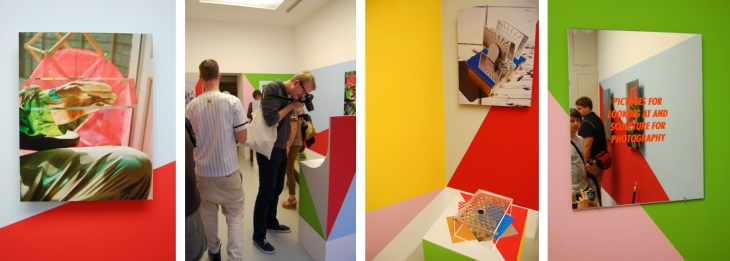This was my first, and most certainly not my last visit to Photomonth. Krakow is a vibrant city with great cultural and historical dignity, providing a glorious backdrop to the annual festival celebrating its tenth year in 2012.
Here is my personal round up of the best bits of this year’s Photomonth in Krakow.
Jason Evans Pictures for Looking at and Sculpture for Photography is a moment of psychedelic sunshine in an otherwise globally white walled gallery experience. Evans’ energy and passion for the art of looking is evident. Photography is to be enjoyed and there’s no doubting the level of fun this multicoloured room and a collection of wooden spoons have brought. Evans invites viewers to interact with his carefully planned sculptures and to photograph and upload their experiences online. If you were there then upload now at www.photographyforsculpture.com

I’ve followed Viviane Sassen’s work and collected her books for some time (see Photoworks Issue 14) but this was my first experience of a Sassen exhibition.
In Parasomnia Sassen invites us to share dreamlike memories of her childhood years in Kenya. For those familiar with the series from her book, it might be hard to imagine the work in exhibition form. The careful juxtaposition and the book’s feeling of flow and playfulness is transferred with some difficulty to the walls of the Pauza Gallery, but the result is nonetheless a carefully selected and beautifully printed selection of images bringing the viewer to the centre of the project.

Canary was my first encounter with the work of Japanese photographer Lieko Shiga. The series began as a book that I believe is now sadly near impossible to get hold of. Shiga asked the residents of Brisbane, Australia, and Sendai, Japan, to choose the “lightest” and “darkest” places in each city; based on that information she attempted to find links between the place and the person who chose it. I’ve not experienced the publication first hand, but understand from opening night conversations that some found part of the publication’s magic missing from the exhibition. I found the works set perfectly in the darkened halls of the Manggha Center of Japanese Art and Technology, her prints appear to glow from the walls and I have no doubts that whether you have been lucky enough to see the book or not, you will thoroughly enjoy this charming exhibition.

Experimental Section
My highlight of this year’s festival will be shared with many. Curated by Charlotte Cotton and working in collaboration with organisations and collectives across Poland, Krakow Photomonth 2012 has produced a successful and innovative participation programme Photography in everyday life.
Visitors are invited to take part in a wide variety of projects, from vast family photo albums and customized Krakow postcards to listening to photography and a project encouraging participants to imagine the contents of a series of empty frames. Participants become simultaneously the directors, artists, curators and the subjects of what will become an archive of 2012 Krakow.
Those attending the festival can head down to the beautiful Bunkier Sztuki and get involved, and I urge those that can’t visit in person to, to explore the experimental section at www.photomonth.com and discover how to get involved virtually .

The combination of beautiful venues with some great emerging talent for this year’s ShowOFF Sectionwas a real treat for the senses. Mateusz Sarello’s project Swell is a visually poetic story of lost love and loneliness. Unfortunately his website www.mateuszsarello.com/baltic only shows the Polaroid images taken at the very beginning of the series. Although these are undoubtedly beautiful images, his enigmatically eerie black and white photographs capturing the movement of waves interested me most.


Equally enigmatic is the work of young polish photographer Tomasz Brodawka, who’s photographs of women with their cats were so well placed in the surroundings of the beautiful Artefakt Café that I couldn’t quite imagine how the walls would cope without them.

Martyna Rudnicka’s project S is about sleep. Spend a little time in the surroundings of the grey walls and scattered light boxes and you begin to understand Rudnicka’s concern is not just with biological need, but with the maintenance of the delicate balance in which all matter exists.
These were my pick of the crop, but here are a couple more interesting projects for your perusal…
Michal Lichtanski, Hotel

Lukasz Rusznica, Inhale

I can’t finish without quickly mentioning the other influential factor in the success of my weekend in Krakow… the food! Head down to U Babci Maliny whose literal translation, Grandmother Raspberry, is reason enough to visit, and enjoy some typical Polish food whilst transfixed with a large fish tank occupying the centre of the room. (I can recommend the mushroom pierogi).
Published on 31 May 2012
Submitted by Sarah Leybourn
Edited by Photoworks

